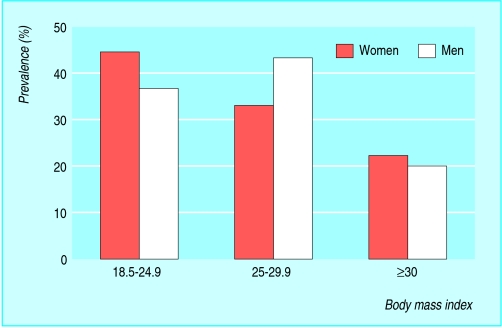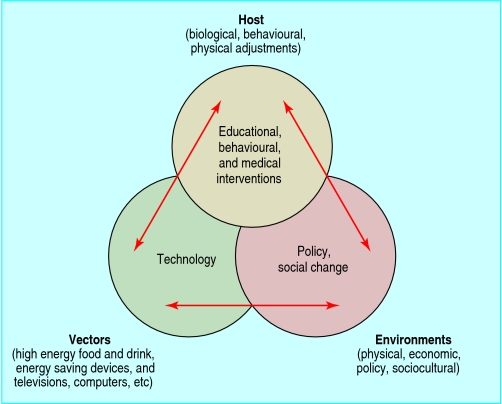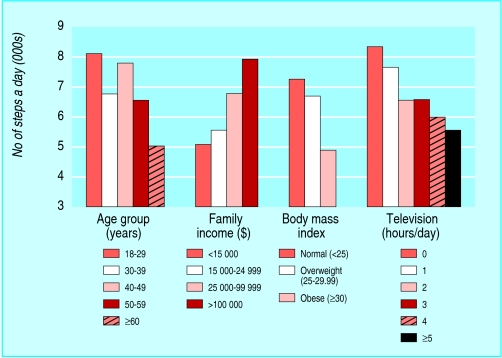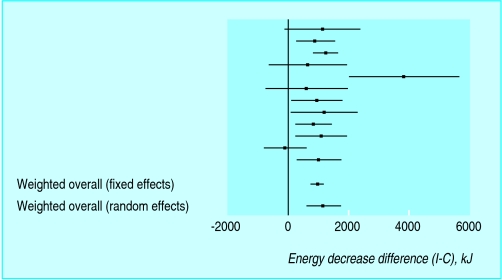Obesity is an epidemic, says the World Health Organization. The prevalence of adult obesity has exceeded 30% in the United States, is over 20% in most of Europe (5-23% in men, 7-36% in women), and is 40-70% in the Gulf states and Polynesian islands. Obesity is also present in low income countries, and low socioeconomic groups are affected most. In most countries the prevalence of obesity now exceeds 15%, the figure used by WHO to define the critical threshold for intervention in nutritional epidemics.
Figure 1.

Obesity is increasingly affecting younger people, with warning signs for the future from the increasing prevalence of overweight in childhood
Table 1.
Differences between individual and population based approaches to obesity. Adapted from Swinburn et al (see Further Reading box)
| Individual based approach | Population based approach | |
|---|---|---|
|
Key measures |
Body weight, waist, body mass index |
Prevalence of overweight and obesity, mean body mass index, mean waist |
|
Key aetiology question |
Why is this person obese (or gaining weight)? |
Why does this population have a high (or rising) prevalence of obesity? |
|
Main aetiological mechanisms |
Genetic, metabolic, hormonal, behavioural |
Environmental, cultural, behavioural |
|
Key management question |
What are the best long term strategies for reducing the person's body fat? |
What are the best long term strategies for reducing the population's mean body fat/waist circumference? |
|
Main management actions |
Patient education, behavioural modification, drugs, surgery |
Public education, improving food, physical activity environments, policy, planning |
|
Volume of information on aetiology and management |
Vast |
Minimal |
|
Driving forces for research and action |
Immediate and powerful |
Distant and weak |
|
Potential for long term benefit to individuals |
Modest |
Modest |
|
Potential for long-term benefit to populations |
Modest |
Significant |
| Sustainability | Poor | High |
Obese people are at high risk of multiple health problems and need full medical management. The numbers are so great (and rising), however, that individual medical care becomes impractical and prohibitively expensive. Currently, the cost of obesity to a country's health service is estimated at up to 9%, and the overall social cost of the condition is seen as a major hindrance to economic development. An even larger proportion of the population is overweight, with increased morbidity. Virtually all the costs (personal, health, and economic) of obesity are met in adulthood and result from fat that has accumulated in adulthood, but there is a likely additional cost due to inactivity and overweight in childhood that should also be considered.
Achieving energy balance
Obesity is a disorder of energy balance (“energy in” equals “energy out”). Weight is steady when energy is balanced. “Positive energy balance” is when the amount of energy consumed as food and drink exceeds the energy used. UK adults on average consume 20 kcal a day more than they expend, leading to an average weight gain of 1 kg a year. Some people who become obese eat 100 kcal a day more than they expend so gain up to 5 kg a year. Any intervention that changes positive energy balance will ultimately be effective in preventing calorie accumulation, thus accumulation of body fat.
The components amenable to intervention are physical activity and overall energy consumption. The absolute level (in kcal/day), at which energy balance occurs is mainly determined by body weight, which affects both the basal metabolic rate and the energy cost of activity. It can be changed by substantial changes in physical activity but also, to a similar degree, by small changes in weight. So some thin people may be active and eat a lot to achieve energy balance, but overweight people have to eat more than most thin people to avoid weight loss.
This purely mechanistic approach cannot be used for health promotion without a fuller understanding of several elements: the balance between individual and genetic predisposition to weight gain; the psychological, social, cultural, and economic and political components of our “obesogenic” environment; and the nature of the “disease vectors” (high energy foods and energy saving devices). Changes in diet and physical activity are necessary for weight loss but do not guarantee it. To avoid compensation (between changes in physical activity and changes in appetite), effective interventions must tackle both diet and physical activity, and in an integrated way.
This is the sixth article in the series
There seems to be strong biological resistance to weight loss once obesity is established. The long term solution must now include effective prevention directed at the whole population
A successful intervention for obesity prevention must influence energy balance but must also be sustainable. Changes in diet and physical activity need to be incorporated into new behaviour patterns, as a need for constant reminders or rewards will result in non-sustainability.
Figure 2.
Prevalence of obesity in the adult Scottish population. These figures combine all ages. Among older people, only a quarter to a third remain in the desirable weight range. Data from Scottish health survey, 1998 (www.show.scot.nhs.uk/scottishhealthsurvey/sh8-00.html)
A permanent change in the environment is the best way to ensure permanent changes. Actions should focus on (a) enabling people to manage energy balance better in the current environment; (b) modifying the vectors of obesity; and (c) changing the current sociopolitical environment, which currently rewards the manufacturers of products and processes that contribute to obesity. Effective programmes for obesity prevention probably encourage both healthy eating and physical activity (rather than rely on separate strategies for eating and activity).
Figure 3.
Epidemiological “triad” as it applies to obesity. Adapted from Swinburn et al (see Further Reading box)
Table 2.
Strategies used by individuals to control weight problems
| • Decrease dietary fat consumption |
| • Skip meals or don't skip meals |
| • Decrease fizzy drinks or replace them with low sugar drinks |
| • Avoid sugary foods and processed high-fat meat products |
| • Increase low energy foods (such as fruits and vegetables) |
| • Choose natural foods if possible, but if buying manufactured or packaged foods, buy those low in energy density |
| • Eat off small plates; avoid large portions (never “super size”) |
| • Never eat with fingers |
| • Only eat when sitting down |
| • Join a gym |
| • Use a gym |
| • Walk to the gym |
| • Walk more and don't bother with the gym |
| • Get a pedometer and use it to monitor increased walking |
Strategies that work
Less than 30% of all people in Western countries avoid becoming overweight and maintain a body mass index of < 25 throughout their adult life. Among this group, many avoid weight gain only by conscious efforts. Of the 75% of all people who will become overweight, about half will become obese. Thus probably about half of all adults are consciously avoiding further weight gain and have a body mass index of < 30. Precisely how they do this is uncertain because of systematic errors in survey methods.
Figure 4.
Colorado “On the Move” survey of walking. Data from Med Sci Sports Exerc 2005;37: 724-30
Participants in the US National Weight Control Registry who have successfully lost an average of 30 kg and maintained that loss report high levels of physical activity, equivalent to about an hour a day of moderate intensity physical activity. Successful “maintainers” also reduce dietary fat intake to a lower level than in the general population.
A recent US telephone survey from the Colorado “On the Move” initiative reports that, on average, individuals of normal weight walk 600 more steps a day than overweight individuals and 2400 more than obese individuals. People aged over 60—particularly widowers, those in low income families, and obese individuals—are the main group who would benefit from increased physical activity. Watching television for over three hours a day is a major barrier to physical activity.
Combining a low fat diet with exercise is particularly valuable for preventing diabetes and hypertension and is likely to be effective in preventing weight gain
Interventions have included increasing physical activity; reducing physical inactivity (usually reducing television viewing); reducing total calories and energy density of foods or dietary fats; and a combination of these strategies.
Figure 5.
Meta-analysis of role of unrestricted low fat diets in body weight control: differences in energy intake in studies lasting two to 12 months (change in intervention (I) minus change in control (C)) with 95% confidence interval. Adapted from Astrup et al (see Further Reading box)
Table 3.
Childhood overweight and obesity
| • Overweight and obesity are increasing in children of all ages, and “obese” teenagers enter adult life already with a BMI > 25 |
| • Although obese children do not often have immediate health problems, and most obese adults were not obese as children, many obese children become obese adults |
| • Efforts to prevent obesity in childhood and its progression into adulthood are fuelled by a belief that it might be possible to influence lifelong behavioural patterns |
Systematic reviews by England's Health Development Agency (now incorporated into the National Institute for Health and Clinical Excellence) and others have concluded that exercise added to a diet programme improves weight loss.
Table 4.
Core actions proposed by WHO
| • Reducing commercial pressure on people (particularly children) to consume high energy products |
| • Reducing fat, sugar, and salt in manufactured products |
| • Enabling easier and cheaper access to healthy food |
| • Introducing measures to improve food and increase physical activity in schools and the workplace |
| • Promoting cycling and walking by better urban design and transport policies |
| • Creating opportunities in local environments for people to be more physically active in their leisure time |
| • Encouraging health services to provide advice on diet and physical activity, and promote exclusive breast feeding |
A meta-analysis of studies on reducing dietary fats by using normal food or food lower in fat concluded that people spontaneously consumed about 270 kcal a day less when following lower fat diets, effectively resetting energy balance at a lower level, thereby avoiding about 15 kg of weight gain.
Measures successful in preventing weight regain after weight loss are likely to apply in primary prevention. Increasing physical activity is a key factor, along with reducing energy intake. Long term prevention has not yet been demonstrated.
Small changes can prevent weight gain
The weight gain and current obesity levels in the US population have been shown to result from only a slight shift towards positive energy balance. Thus most weight gain could be prevented with small behavioural changes of this order, such as increased walking, small decreases in dietary fat or sugar intake, and smaller portion sizes. This approach is likely to be more sustainable and effective in preventing weight gain than advocating unnecessary larger changes.
Interventions in children
School based programmes seem promising. They can increase physical activity, particularly in girls, and to a certain extent can modify dietary intake. The effects on weight are not apparent, possibly owing to the short duration of the interventions. Changing the school environment to reduce consumption of high energy food, such as fizzy drinks and foods high in fat and sugar, may help. For example, reducing the consumption of fizzy drinks for 12 months among 7-11 year olds can reduce the prevalence of overweight and obesity by 7.5%. Serving lower fat versions of some popular school lunch items reduces fat intake without affecting attractiveness or palatability.
Preventive measures for the future
The World Health Organization's Regional Office for Europe considers obesity prevention to be one of its highest priorities. It called for immediate, comprehensive action by governments and others in society by arranging a ministerial conference on counteracting obesity for November this year.
The organisation is advocating a range of actions that would make it easier for people to adopt a healthy lifestyle. The aim is to prevent further increase in obesity rates and to reduce rates progressively in the next decade. Given the rising prevalence of obesity, even attenuating the rise should be seen as a success. A further problem for health planners is that obesity and its secondary health costs are associated with more socially deprived and minority population groups. Any measures based on cognitive, educative interventions will tend to benefit more educated and affluent people, thus accentuating the social health gradient. Measures directed at changing the price, availability, and nutritional characteristics of food may have a positive effect across social groups.
Over 90% of the weight gain seen in US adults results from a positive energy balance of <100 kcal a day
The World Health Organization has convened a ministerial conference on “counteracting obesity” in Istanbul, Turkey, in November this year, where a charter on counteracting obesity will be signed
WHO has advocated the involvement of the different government sectors, as well as the private sector and civil society. The European Union's initiative the “Platform on Diet and Physical Activity” has stimulated commitments from the food industry and advertisers. The relevance and effectiveness of these commitments is being evaluated. The US private sector has sponsored initiatives such as “America on the Move,” which is based on the “small changes” approach.
Figure 6.

America on the Move uses the principle that increasing the daily number of steps walked by 2000 above current levels (using a pedometer), plus choosing one way to cut out 100 kcal, can prevent weight gain in most children and their parents
One scenario includes the reduction of existing obesity. On average, adults now eat 500-600 kcal more than they did 30 years ago, of which 50 kcal a day represent continuing weight gain and about 500 kcal a day maintain current levels of overweight and obesity. If everyone were to eat 500-600 kcal a day less than they currently do, then their weight would fall by 10-30 kg and current obesity levels would reduce to those of 30 years ago. This strategy, however, works for less than 30% of people attending one-to-one obesity clinics and its success on a large scale seems improbable.
The alternative scenario—a “small changes” strategy—is more realistic. This strategy aims to increase physical activity and reduce energy intake both by 100 kcal a day to prevent further weight gain. It accepts that those already overweight and obese will remain so. The next generation is thus the true target for obesity prevention—lifestyle changes would be started in childhood and sustained for life.
The photographs on the first page and this page are published with permission from Gusto/SPL and David Zalubowski/AP/Empics respectively.
The ABC of Obesity is edited by Naveed Sattar (nsattar@clinmed.gla.ac.uk), professor of metabolic medicine, and Mike Lean, professor of nutrition, University of Glasgow. The series will be published as a book by Blackwell Publishing in early 2007.
Competing interests: James O Hill has served on advisory panels and received consulting fees from PepsiCo, General Mills, GSK
Pharmaceuticals, and Slimfast Nutrition. He has received funding from McNeil Nutritionals. For series editors' competing interests, see the first article in this series.
References
- • Astrup A, Grunwald GK, Melanson EL, Saris WH, Hill JO. The role of low-fat diets in body weight control: a meta-analysis of ad libitum dietary intervention studies. Int J Obes Relat Metab Disord 2000;24: 1545-52. [DOI] [PubMed] [Google Scholar]
- • Avenell A, Broom J, Brown TJ, Poobalan A, Aucott L, Stearns SC, et al. Systematic review of the long-term effects and economic consequences of treatments for obesity and implications for health improvement. Health Technol Assess 2004;8(21). [DOI] [PubMed]
- • Fogelholm M, Kukkonen-Harjula K. Does physical activity prevent weight gain—a systematic review. Obes Rev 2000;1: 95-111. [DOI] [PubMed] [Google Scholar]
- • James J, Thomas P, Cavan D, Kerr D. Preventing childhood obesity by reducing consumption of carbonated drinks: cluster randomised controlled trial. BMJ 2004;328: 1237-9. [DOI] [PMC free article] [PubMed] [Google Scholar]
- • Swinburn B, Egger G. Preventive strategies against weight gain and obesity. Obes Rev 2002;3: 289-301. [DOI] [PubMed] [Google Scholar]
- • World Health Organization. Obesity: preventing and managing the global epidemic. Geneva: WHO, 1997. (WHO Technical Report Series, No 894.) [PubMed]
- • Rodearmel SJ, Wyatt HR, Barry MJ, Dong F, Pan D, Israel RG, et al. A family-based approach to preventing excessive weight gain. Obesity 2006;14: 1392-401. [DOI] [PubMed] [Google Scholar]






